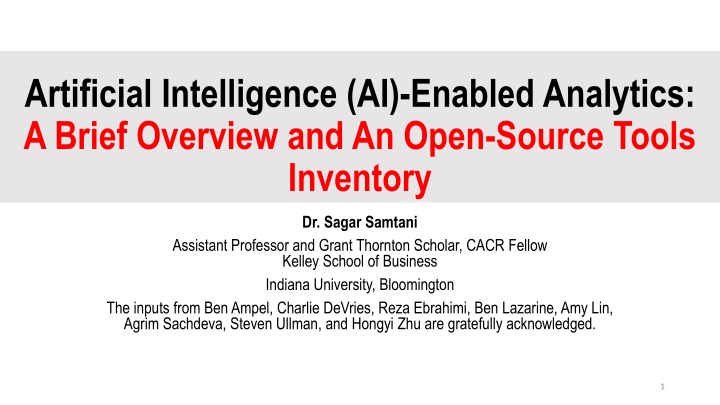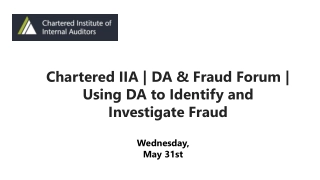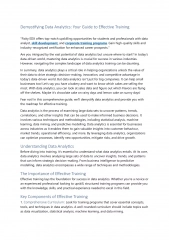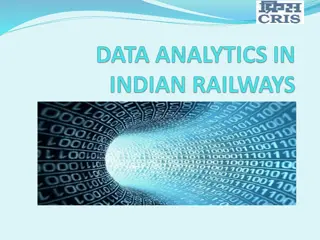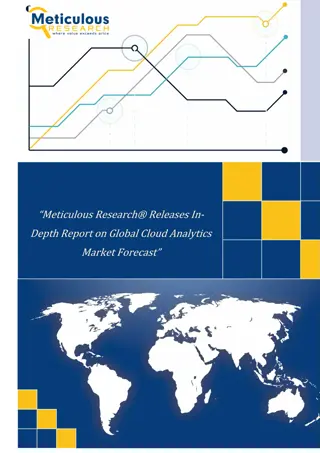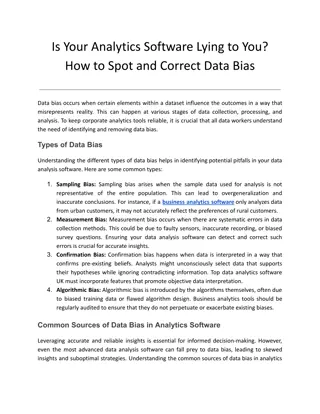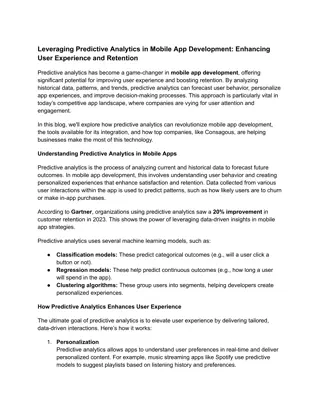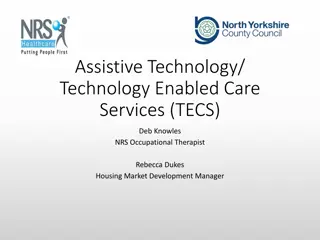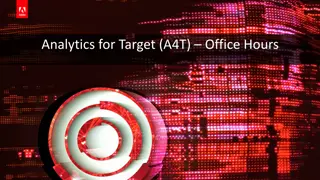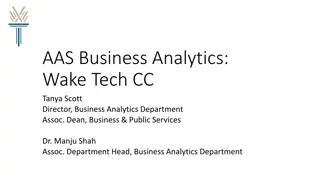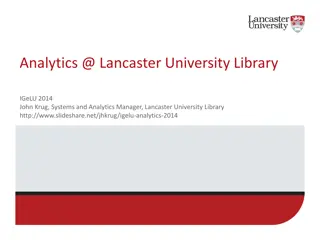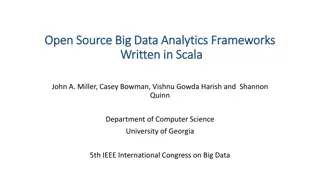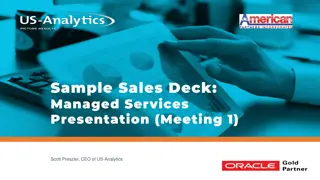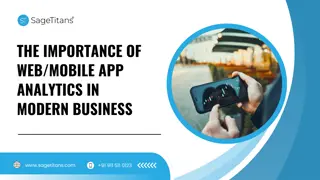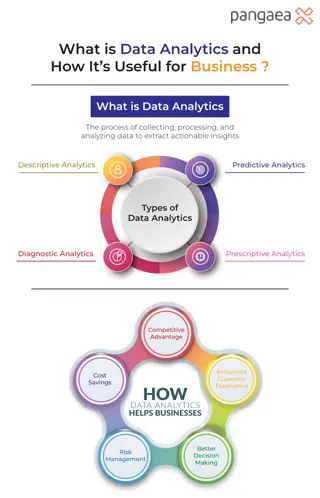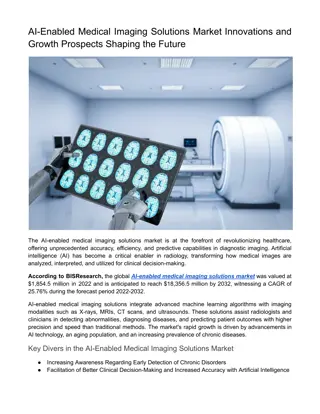AI-Enabled Analytics Overview
Artificial Intelligence (AI) has rapidly emerged as a disruptive technology of the 21st century, showing promise in various applications like robotics, drones, and self-driving cars. Organizations are increasingly exploring how AI can analyze structured and unstructured data, leading to the rise of AI-enabled analytics. This process involves data collection, extraction, analysis, and visualization to produce actionable insights across domains such as business intelligence and cybersecurity.
Download Presentation

Please find below an Image/Link to download the presentation.
The content on the website is provided AS IS for your information and personal use only. It may not be sold, licensed, or shared on other websites without obtaining consent from the author.If you encounter any issues during the download, it is possible that the publisher has removed the file from their server.
You are allowed to download the files provided on this website for personal or commercial use, subject to the condition that they are used lawfully. All files are the property of their respective owners.
The content on the website is provided AS IS for your information and personal use only. It may not be sold, licensed, or shared on other websites without obtaining consent from the author.
E N D
Presentation Transcript
Artificial Intelligence (AI)-Enabled Analytics: A Brief Overview and An Open-Source Tools Inventory Dr. Sagar Samtani Assistant Professor and Grant Thornton Scholar, CACR Fellow Kelley School of Business Indiana University, Bloomington The inputs from Ben Ampel, Charlie DeVries, Reza Ebrahimi, Ben Lazarine, Amy Lin, Agrim Sachdeva, Steven Ullman, and Hongyi Zhu are gratefully acknowledged. 1
Outline Background of AI-enabled Analytics An Open-Source Tools Inventory for AI-enabled Analytics 1. Data Collection and Aggregation 2. Data Extraction and Representation 3. Analytics 4. Visualization and Presentation 5. Other Selected Resources Conclusion Summary 2
A Brief Background of AI-enabled Analytics Artificial Intelligence (AI) has rapidly emerged as a key disruptive technology of the 21st century. AI has shown significant promise in various application areas, including robotics, game playing, drones, self-driving cars, and others. Increasingly, many organizations are seeking to identify how AI can help analyze their structured (e.g., transactions) and unstructured data (e.g., text, sensor signals). This interest is giving rise to an emerging field of AI-enabled analytics. An abstracted approach to conducting AI-enabled analytics is presented in Figure 1. 3
A Brief Background of AI-enabled Analytics Phase 1: Data Collection and Aggregation Phase 2: Data Extraction and Representation Phase 4: Visualization and Presentation Phase 3: Analytics Description: Collect data from various source(s) based on domain need and/or business understanding Description: Pre- process collected data and structure (represent) data for analysis Description: Analyze collected data to produce relevant and actionable insights Description: Present data and analytics results to facilitate decision making Approaches: Machine learning, deep learning, text analytics, network science, entity matching, IR Approaches: APIs, web crawling, simple downloads, data warehouse querying Approaches: summary statistics, feature extraction, cleaning, imputation Approaches: Visualizations, dashboards, web front- ends, HCI Figure 1. An Abstracted (Domain-agnostic) Approach to Conducting AI-enabled Analytics 4
A Brief Background of AI-enabled Analytics This process can be executed for different domains, including BI&A (Chen et al. 2012), cybersecurity (Samtani et al. 2020), and privacy (Samtani et al. 2021). Most successful implementations of AI-enabled analytics are based on a strong understanding of the domain or business being studied. Understanding of domain or business can be based on: How domain experts or professionals execute their tasks (e.g., workflows) Regulations and statutes e.g., HIPAA, GDPR, CCPA Extant frameworks e.g., cybersecurity risk management frameworks 5
An Open-Source Tools Inventory for AI-enabled Analytics Executing each phase of the AI-enabled analytics requires a set of tools. Therefore, a review of prevailing tools was conducted. The review was conducted based on the following key criteria: 1. Tools should be open-source, rather than paid (to help with cost management). 2. Tools should be interoperable with Python and with SQL or NoSQL. Tools are organized based on each major AI-enabled analytics phase. For each identified tool, a brief description and a link to the tool are provided. Important! Some tools can perform multiple functions e.g., both extract and analyze. 6
An Open-Source Tools Inventory for AI-enabled Analytics Data Collection and Aggregation Data collection and aggregation is focused on collecting data that could be used for subsequent analysis. This phase comprises tools (Table 1) for: Collection: Mechanisms to access and collect (crawl, download) the data sources. Storage: Storing data for users to query and to serve as a backend for web portals. Task Tool/Package Name(s) Description Documentation Collection Scrapy Package for incremental web crawlers https://scrapy.org/ JSON Package for parsing JSON data from APIs https://docs.python.org/3/library/json.html BeautifulSoup Package for general web crawling https://pypi.org/project/beautifulsoup4/ Google BigQuery Queriable data warehouse of public datasets https://cloud.google.com/bigquery Paramiko SSH connection to extract data from VMs https://www.paramiko.org/ Storage MySQL Relational database https://www.mysql.com/ Pickle Storing ML/DL models https://docs.python.org/3/library/pickle.html MongoDB NoSQL database https://www.mongodb.com/ Elasticsearch NoSQL database for storing documents https://www.elastic.co/ Neo4j NoSQL database for storing graph data https://neo4j.com/v2/ Hadoop Framework that allows distributed storage Table 1. Open-Source Tools for Data Collection and Aggregation https://hadoop.apache.org 7
An Open-Source Tools Inventory for AI-enabled Analytics Data Extraction and Representation Since collected data is rarely in a format that can be directly analyzed, relevant data of interest (based on business/domain needs) should be: Extracted from its original, raw format and cleaned (pre-processed) to remove noise. Represented in a data structure (e.g., vector, graph, grid) suitable for the targeted analytics Common tasks include producing summary statistics, imputation, deduplication, cleaning, annotation, and many others. Prevailing tools appear in Table 2. Tool/Package Name(s)* Description re Support regular expression matching Documentation https://docs.python.org/3/library/re.html numpy Creation and operations on multi-dimensional numeric arrays https://numpy.org Data Analysis Baseline Library Common ML pre-processing tasks https://amueller.github.io/dabl/dev/ Pandas Formatting and structure data inputs from varying data sources https://pandas.pydata.org/ SideTable Advanced data-wrangling with Python https://pbpython.com/sidetable.html Pigeon Interface to rapidly annotate unlabeled data Table 2. Open-Source Tools for Data Extraction and Representation https://github.com/agermanidis/pigeon 8
An Open-Source Tools Inventory for AI-enabled Analytics Analytics The analytics phase is the heart of conducting AI-enabled analytics. In this set of slides, six sets of analytics are covered: 1. Conventional Machine Learning (ML): Approaches that learn from feature vectors. 2. Deep Learning (DL): Approaches that learn from data structures (e.g., grids, sequences). 3. Text Analytics: Techniques that aim to extract insights from unstructured text data. 4. Network Science: Approaches that analyze graph or tree-structured data. 5. Information Retrieval (IR) and Entity Resolution (ER): Techniques that link multiple sources of data (for retrieval or resolution). 6. Emerging Learning Paradigms: Specialized approaches for learning from data beyond the classical supervised learning and unsupervised learning perspectives. Although not comprehensive of *all* analytics approaches, the listed categories represent some of the most popular and prevailing at the time of this writing (2022). A (very) brief summary of the underlying concepts for each analytics procedure is provided. 9
An Open-Source Tools Inventory for AI-enabled Analytics Analytics (Conventional ML) Conventional ML techniques and tasks have historically been the most closely associated with AI-enabled analytics. Conventional ML can be broadly categorized into: Supervised learning: Aims to predict an output variable based on a set of input (independent) variables (features). Process: gold-standard dataset development feature extraction model (e.g., SVM) selection and training model evaluation (e.g., hold-out, CV, performance measurement via accuracy, precision, recall, F1) model tuning Unsupervised learning: Aims to find the natural relationships (e.g., partitions, associations) of data instances within a dataset. Common approaches: clustering (hierarchical, partitional), association rule mining. 10
An Open-Source Tools Inventory for AI-enabled Analytics Analytics (Conventional ML) Three major categories of conventional ML tools exist (Table 3): 1. ML packages that include a comprehensive set of ML algorithms and procedures. 2. GUI-based ML workflows that allow users to conduct ML in a drag-and-drop fashion 3. AutoML tools that automate aspects of the conventional ML process (e.g., tuning parameters). Each tool provides a suite of conventional ML algorithms and mechanisms to evaluate the performance of ML algorithms. Category ML packages Tool/Package Name(s) Scikit-learn Brief Description Documentation Basic ML algorithm implementation and evaluation https://scikit-learn.org/stable/ Spark Unified analytics engine for large-scale data processing https://spark.apache.org GUI-based ML workflows RapidMiner GUI-based, general purpose ML toolkits for creating workflows https://rapidminer.com/ WEKA https://www.cs.waikato.ac.nz/ml/weka/ AutoML TPOT Sklearn-based AutoML feature selection and model selection https://epistasislab.github.io/tpot/ HyperOpt Sklearn-based AutoML ML hyperparameter tuner Table 3. Open-Source Tools Conventional ML-based Analytics https://hyperopt.github.io/hyperopt-sklearn 11
An Open-Source Tools Inventory for AI-enabled Analytics Analytics (Deep Learning) DL has rapidly emerged as an approach to automatically extract multiple levels of features (representations, embeddings) from raw data. DL comprises: Data encoding structures the raw data into a format (e.g., grid) for a DL model to learn from. Basic processing units (architectures) such as ANN, CNN, RNN, and GNN that operate on the data encoding. Architecture extensions (e.g., attention, highway, bidirectional processing) to improve the model s capacity to learn from the data encoding. Learning paradigm (e.g., supervised, unsupervised, adversarial) that defines how the model learns from the data encoding. Many DL approaches are deployed using supervised learning or unsupervised learning paradigms and therefore follow evaluation approaches as conventional ML. However, they are also used with many emerging learning paradigms (see Table 8). 12
An Open-Source Tools Inventory for AI-enabled Analytics Analytics (Deep Learning) A summary of prevailing open-source tools for conducting DL-based analytics is presented in Table 4. Some key takeaways of the tools include: Keras offers some of the most user-friendly approaches to executing basic DL with supervised, unsupervised, adversarial, or transfer learning. PyTorch is excellent for customizing DL models (e.g., loss) for specific applications. Huggingface and SimpleTransformers provide access to large pre-trained models (e.g., BERT, GPT) as well as emerging architectures, namely, transformers. Tool/Package Name(s) Brief Description Documentation Pytorch Advanced Python package for customizable deep learning https://pytorch.org/ Keras Basic package with standard DL algorithms https://keras.io/ fastai Various tools and resources for DL https://www.fast.ai/ Huggingface Large repository of pre-trained language models (e.g., BERT) https://github.com/huggingface SimpleTransformers Barebones implementation of pre-trained language models Table 4. Open-Source Tools for DL-based Analytics https://github.com/ThilinaRajapakse/simpletransformers 13
An Open-Source Tools Inventory for AI-enabled Analytics Analytics (Text Analytics) Many modern data sources, especially for BI&A, are text-based. Three major categories of tools for text analytics exist (Table 5). 1. Multi-purpose general text analytics that supports common text analytics 2. Specialized text analytics for particular types of text analytics tasks (e.g., NER, PoS) 3. Multi-lingual analytics to support analysis of text in non-English languages. Category Tool/Package Name(s) Brief Description Multi-purpose text analytics Spacy Industrial strength, large-scale information extraction and NLP Documentation NLTK Python package for symbolic and statistical NLP https://www.nltk.org/ https://spacy.io/ Specialized text analytics Flair PyTorch extension for NER, PoS, and custom embeddings https://github.com/flairNLP/flair T-NER Pre-trained language models for NER https://github.com/asahi417/tner Gensim Package for basic word embeddings and topic modelling https://radimrehurek.com/gensim/ Multi-lingual analytics Textflint Unified multi-lingual robustness evaluation toolkit for NLP https://github.com/textflint/textflint Polyglot NLP pipeline for multi-lingual analysis (supports 196 languages) https://polyglot.readthedocs.io/en/latest/ Stanza Python package from Stanford for multi-lingual analysis Table 5. Open-Source Tools for Text Analytics https://stanfordnlp.github.io/stanza/ 14
An Open-Source Tools Inventory for AI-enabled Analytics Analytics (Network Science) Many contexts can be represented as a network (e.g., graph) that captures relationships (edges) between different entities (nodes). In recent years, network science been conducted with two major categories of tasks (Table 6) 1. Graph Construction and Analysis (1) represents a graph and (2) extracts graph-level properties (e.g., density, diameter), node-level statistics (e.g., centralities), and structures (e.g., communities). 2. Graph Embedding techniques aim to project various components of a graph (e.g., nodes, edges, etc.) into a low-dimensional space to facilitate downstream analysis (e.g., classification, propagation). Category Tool/Package Name(s) Brief Description Documentation Graph Construction and Analysis Networkx Python package for basic network science tasks https://networkx.github.io/ igraph Package for extensive (non-DL) network science https://igraph.org/python/ Graph Embeddings stellargraph Graph embedding package with common graph embedding methods https://github.com/stellargraph/stellargraph PyG PyTorch-based library to develop custom Graph Neural Network https://pytorch-geometric.readthedocs.io/ Deep Graph Library Python package for deep learning on graphs Table 6. Open-Source Tools for Network Science Based on Task Category https://www.dgl.ai/ 15
An Open-Source Tools Inventory for AI-enabled Analytics Analytics (IR and ER) Many organizations have access to multiple modalities or sources of data. Linking data instances across these different sources is of growing interest. Increasingly, two major approaches (major open-source tools summarized in Table 7) are being leveraged for multi-modal analysis, particularly linking: Information Retrieval tasks such as Q&A systems, short text matching, search engines, etc. often aim to retrieve an entity (e.g., document) based on a key (e.g., query). Entity resolution seeks to resolve different data instances that refer to the same entity. Category Tool/Package Name(s) Brief Description Documentation Information Retrieval MatchZoo Short text matching and deep structured semantic modeling https://ntmc-community.github.io/ Pyserini Implementations of non-DL-based IR algorithms https://github.com/castorini/pyserini OpenMatch Algorithms for document matching https://github.com/thunlp/OpenMatch Entity Resolution RecordLinkage Supports non-DL-based entity resolution Table 7. Open-Source Tools for Information Retrieval and Entity Resolution https://github.com/J535D165/recordlinkage 16
An Open-Source Tools Inventory for AI-enabled Analytics Analytics (Emerging Learning Paradigms) Many extant analytics are based in supervised learning or unsupervised learning. However, an increasing body of work, especially in DL, is leveraging learning paradigms that go beyond this dichotomy and more closely emulate a human s learning. 1. Transfer Learning and Knowledge Distillation transfer or distill knowledge between models. 2. Reinforcement Learning has an agent to learn from an environment using feedback from its actions. 3. Self-Supervised Learning aims to obtain supervisory signals (labels) from the data itself by leveraging the underlying structure of the data (to generate labels) during the model training process. Category Tool/Package Name(s) Brief Description Documentation Transfer Learning and Knowledge Distillation TLlib Transfer learning library built on PyTorch https://github.com/thuml/Transfer-Learning-Library KD Awesome List A list of open-source repositories for knowledge distillation https://github.com/FLHonker/Awesome-Knowledge-Distillation Reinforcement Learning OpenAI Gym Provides pre-built environments to execute RL methods https://gym.openai.com Coach Offers various RL agents and algorithms https://github.com/IntelLabs/coach Self-Supervised Learning VISSL Self-supervised learning from images https://vissl.ai/ Graph SSL Awesome List Supports self-supervised learning on graphs Table 8. Open-Source Tools for Emerging Learning Paradigms https://github.com/LirongWu/awesome-graph-self-supervised-learning 17
An Open-Source Tools Inventory for AI-enabled Analytics Visualization and Presentation Visualizations and web-based user interfaces (UIs) can help end-users realize the full potential of insights extracted from AI-enabled analytics. Can help facilitate effective decision-making processes and improve AI trust. Visualizations can also enable A/B tests or user evaluations e.g., usability, ease of use, usefulness, validation of algorithm results, task completion, etc. A summary of prevailing visualization and web front-end tools is presented in Table 9. 18
An Open-Source Tools Inventory for AI-enabled Analytics Visualization and Presentation Task Tool/Package Name(s) Brief Description Visualization Seaborn Basic Python-based statistical visualization package Documentation https://seaborn.pydata.org/ Plotly Advanced Python-based visualization package for ML/DL https://plotly.com/ TensorBoard TensorFlow's visualization toolkit, works with PyTorch https://www.tensorflow.org/tensorboard Web front-end Streamlit Python package for rapid prototyping of DL/ML-based systems https://www.streamlit.io/ Django Python-based web application technologies https://www.djangoproject.com/ Gradio Python package for rapid DL/ML model demonstrations https://gradio.app/ Plotly Dash Framework to build ML and data science web applications https://github.com/plotly/dash Netlify Hosting and serverless webapps with GitHub integrations https://www.netlify.com/ Hugo/Hugon Rapid static site generator Table 9. Open-Source Tools for Visualization and Presentation https://gohugo.io/ Key Takeaways: Visualization tools are available to directly visualize (1) the raw, collected data and/or (2) the outputs of an analytics (e.g., DL) procedure. Most web-front end technologies are relying on serverless architectures to help facilitate rapid prototyping and development without employing extensive server stacks (e.g., XAMPP). 19
An Open-Source Tools Inventory for AI-enabled Analytics Other Resources Since AI is rapidly evolving, it is very important to keep abreast of recent developments to help maximize the value of AI-enabled analytics. Three key areas can be monitored to identify the latest approaches that could be leveraged for AI-enabled analytics. 1. Foundational AI conferences that offer thoughts on theoretical or fundamental AI. 2. Applied AI conferences that employ or adapt AI for specific application areas. 3. Non-peer reviewed public materials that provide code examples, new applications, tutorials, courses, etc. related to various aspects of AI 20
An Open-Source Tools Inventory for AI-enabled Analytics Other Resources Selected Conference/Platform Focus of Conference and Description of Resource Category Size Primary Audience(s) Foundational AI Conferences NeurIPs ML and computational neuroscience with topical workshops 1,900 papers in 2020 Academics and industry ICML Fundamental ML methodologies with topical workshops 1,088 papers in 2020 Academics and industry ICLR Constructing and processing representations for ML 860 papers in 2021 Academics and industry Applied AI Conferences ACM KDD and IEEE ICDM Applied ML and data mining conferences with topical workshops ~3K papers in 2020 Academics and industry ACM CIKM Knowledge and information management with topical workshops 1,367 papers in 2020 Academics and industry AAAI Conference focused on promoting 1,594 papers in 2020 Academics and industry ICCV and CVPR Applied and fundamental computer vision tasks ~2,400 in 2020 Academics and industry ICPPT A prevailing conference for quantum computing research Not Listed Academics and industry RAAI and IEEE Robotic Computing Prevailing conferences for applied and fundamental robotics Not Listed Academics and industry Open Data Science Conference AI thought leadership for various application areas 5K+ attendees Industry Non-Peer Reviewed Public Materials ArXiv Preprint server with published and unpublished work ~2K+ AI pre-prints posted daily Academic Machine Learning Mastery Online tutorial website for ML with sample code and e-books 1K+ tutorials Academic, industry, students Stack Overflow Question-Answer site for code related queries 50M questions Papers with Code Directory of academic AI papers with public code bases 197,327 papers Academic University level courses MOOCs, publicly accessible courses Varies Students Companies with open-sourced AI Companies that use AI that provide their code bases (e.g., Elastic) Varies Industry 21 Table 10. Summary of Other Selected Resources for AI-enabled Analytics
An Open-Source Tools Inventory for AI-enabled Analytics Other Resources Documenting an AI-enabled analytics process is essential to maintaining good progress. Common mechanisms include: IDE s and Package Management: PyCharm, Jupyter, Anaconda Navigator Code repositories: GitHub, Stack Overflow Communication Software: Slack, Zoom, Skype, Teams, Outlook Citation Management: PaperPile (with plugins), Google Scholar Note Management and Collaboration: Confluence, Notability, Evernote Public presence: Google Scholar profile, DBLP, Semantic Scholar, personal website Keeping these up to date can help you quickly develop a suite of resources to rapidly advance processes and help onboard new members quickly! 22
Summary AI-enabled analytics is a rapidly growing area of modern AI. Has shown promise in high-impact applications (e.g., BI&A, cybersecurity, privacy). The AI-enabled analytics process includes (1) Data Collection and Aggregation, (2) Data Extraction and Representation, (3) Analytics, and (4) Visualization and Presentation. Process is based on careful domain/business understanding. In this set of slides, a review of prevailing open-source tools for each phase of the AI-enabled analytics process. These slides reflect tools as of April 2022 and will be updated in the future. 23
References Chen, H., Chiang, R. H. L., and Storey, V. C. 2012. Business Intelligence and Analytics: From Big Data To Big Impact, Management Information Systems Quarterly (36:4), pp. 1165 1188. (https://doi.org/10.1145/2463676.2463712). Samtani, S., Kantarcioglu, M., and Chen, H. 2020. Trailblazing the Artificial Intelligence for Cybersecurity Discipline: A Multi-Disciplinary Research Roadmap, ACM Trans. Manage. Inf. Syst. (11:4), New York, NY, USA: Association for Computing Machinery, pp. 1 19. (https://dl.acm.org/doi/abs/10.1145/3430360). Samtani, S., Kantarcioglu, M., and Chen, H. 2021. A Multi-Disciplinary Perspective for Conducting Artificial Intelligence-Enabled Privacy Analytics: Connecting Data, Algorithms, and Systems, ACM Trans. Manage. Inf. Syst. (12:1), New York, NY, USA: Association for Computing Machinery, pp. 1 18. (https://doi.org/10.1145/3447507). 24
